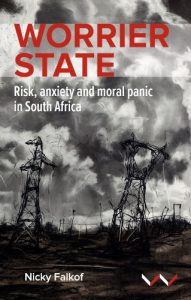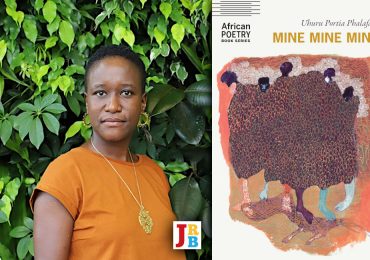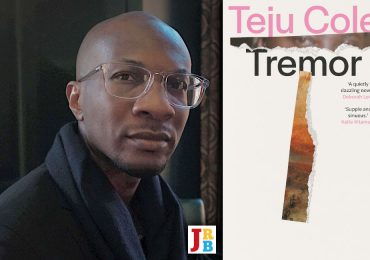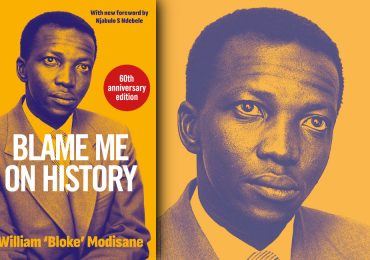The JRB presents an excerpt from Nicky Falkof’s new book Worrier State: Risk, Anxiety and Moral Panic in South Africa.

Worrier State: Risk, Anxiety and Moral Panic in South Africa
Nicky Falkof
Wits University Press
Introduction
In a bright summer month in 2012, equipped with new degrees and new ideas, I returned to South Africa after years of living abroad. My homecoming was joyful but also disconcerting. Friends, family and acquaintances seemed concerned that my time in the UK had robbed me of my street-smart reflexes and I was soon inundated with advice on how to survive in my home country. Living safely in South Africa, it seemed, required an insider’s access to sometimes arcane, sometimes counter-intuitive knowledge. Talk of crime, risk, danger, security and social decay peppered these conversations, some of which were full of indignant confusion that I would sacrifice a ‘safe’ life in England for the risky, unsettling realities of home.
I was told that it was important to pick a safe neighbourhood to live in and to rent a property that had adequate security, in the form of bars, electric fences, motion sensor beams and armed guards who would arrive at the touch of a panic button. It was not just criminal outsiders who posed a problem: I should also be wary of untrustworthy landlords, housemates and domestic workers, as well as neighbours and their employees who may be watching my home. I had to be careful opening doors to strangers and should check the credentials of municipal workers before allowing them to enter. Mysterious symbols chalked on walls meant that a house had been earmarked for a break-in, while ‘everybody knew’ that you just could not go to or through certain areas of the city. I was to sign up for private medical insurance immediately in case ‘something happened’, as I would also be unsafe—albeit in different ways—at a public hospital. I should watch out for scams at banks or through my cellphone. Strangers, as a rule, were not to be trusted.
Getting around was particularly fraught with danger. I was absolutely not to walk anywhere after dark and should avoid walking alone during the day. Commuting by bicycle or using public buses and minibus taxis was out of the question for a middle-class white woman. I should only use private taxis if I was already familiar with a driver. My best option would be to buy a car, after which I must watch out for drunk drivers, potholes and bad roads. When driving at night I was to make sure never to pause at a traffic light or stop sign as these were prime targets for hijackers and smash-and-grab thieves. I was also, however, never to go through a traffic light or stop sign as minibus taxis were notoriously aggressive, careless of laws and likely to smash into me given half a chance. Moving was risky; so was staying still.(1)
Many of these dramatic tales of risk and threat were racialised, sometimes overtly. White acquaintances, and much of the media and political discourse that was aimed at them/us, made it clear that black men in particular presented a threat to my safety. These theories were offered as self-evident truths in the face of a silencing ‘political correctness’ that further endangered people—that is, people like ‘us’—by forbidding us from acknowledging the sources of peril. They were claims to pragmatism, positioned in opposition to a perceived policing of speech that may offend the delicate sensibilities of ‘liberal’ whites but that nonetheless ‘needed to be said’. Such arguments, usually casually made, were distressing and enraging, not least in their assumption that, as a white person, I would automatically agree with them. And yet despite my commitment to anti-racism, despite my desire to perceive myself as a ‘good’ white who is not like ‘those others’ (Thompson 2003), I too felt, and still feel, anxious in some parts of the city. I have found myself clutching my handbag more tightly or locking the doors of my car in response to seeing certain kinds of people on the street: usually black, always male. While I am painfully conscious of the racial nature of these emotions and the centuries-long historical injustice that underpins them, I nonetheless cannot deny that I feel them, even as my ethical/conscious self pulls back in disgust. My determination to move lightly through the streets of Johannesburg has been compromised by these deep and ambivalent fears, by my sense of outsiderness in the inner city, by the seemingly endless conversations about crime and danger that characterise South African ‘white talk’ (Steyn 2004) and by the affective overload of the ‘fortress architecture’ in the suburbs where I live (Murray 2011). As much as I tried to resist it, my experience of returning home was fraught with the complexities of negotiating a fear that is social as much as personal. Coming back to South Africa has made it clear that my politics cannot unsettle the parts of my identity I am uncomfortable with; rather, as Robyn Weigman would have it, I must face the possibility that ‘white antiracism is itself a symptomatic feature of white self- and social mastery, not its political or epistemological displacement’ (2012, p. 140).
These anxieties about security and identity, along with many others, have been echoed and expanded upon by colleagues and students, by politicians, community leaders and social media celebrities, by vulnerable workers and cautious foreigners, and appear in multiple forms within the traditional and digital media that I encounter. It is clearly not just wealthy whites who are worried. Criminals, dangerous drivers, homeless people, corrupt police, bad hospitals and abusive employers are all objects of collective concern. People worry daily about the economy, the safety of their bodies and possessions, the condition of roads and other infrastructure, failing institutions and unreliable politicians, apparently uncontrolled influxes of people from elsewhere in Africa, experiences or accusations of racism, tainted food, HIV and other diseases, skills shortages, job shortages, the education system and a host of other concerns, most of which have been dramatically exacerbated by the Covid-19 pandemic. Suffused with all of these intense and often collective emotions, twenty-first-century South Africa seems like a particularly fearful place to be.
Nonetheless, as I write this preface some years after my return to South Africa, it is clear that life continues amongst these powerful emotional currents. The insecurity of township existence is interspersed with the warm hospitality of community celebration. People navigate treacherous taxi ranks and reckless cross-country drivers to maintain connections with faraway family and friends. Children grow up knowing both bustling cities and grandparents’ villages. Sangomas and psychotherapists alike do a busy trade, while suburban elites continue to enjoy cheap domestic labour alongside high-end cars and handbags. Queer people escape conservative homes to emerge phoenix-like into the hybrid Afro-chic aesthetic of the big cities. People develop friendships and love affairs across differences of class, race, language and nationality. Daily life is suffused with soap opera, celebrity, consumption, negotiation and other common components of the everyday in the burgeoning cities of Africa. For all its negative consequences, anxiety in South Africa does not impede existence; it has rather become part of existence, unsurprising, quotidian, expected. This condition is inherently linked to South Africans’ hypermodern subjectivity as citizens of late capitalism, and has much to tell us about contemporary popular cultural imaginings of selfhood, identity and Africa.
As its contribution to thinking through such imaginings, this book is concerned with four stories. The chapters that follow consider the ‘white genocide’ conspiracy theory that has been propagated by Afrikaner elites; the murders of three young women, attributed to the influence of an evil satanic cult, or even literally to the devil; an urban legend around violent and occult crime in Alexandra township, Johannesburg; and folk theories about citizenship and safety among suburban residents in Melville, also in Johannesburg. Taking in various locations and concerning people of different economic classes and racialised categories, these stories reveal that themes of fear, crime, precarity, safety and belonging criss-cross South African society in wildly different ways. Anxiety, this book argues, is a constant condition of South African life; but rather than meaning only one thing, it is entirely different for different people and communities. Anxiety does not unite us. Its manifestations depend on its proximity to whiteness and power, on the varying narratives that underlie it, on the conditions of life of those who find themselves at its mercy. For some of us, anxiety is a manifestation of woolly, often repressed mythologies; for others, it is a response to the daily risk and grind of life in this most unequal country. Cultures of fear also add to our distance from each other by demonising difference, fostering paranoia and closing communities. These particular tales, while radically different in terms of the risks, concerns and conditions that foster them, have in common their imbrication in narrative; their racialised, gendered and classed components; and their emphasis on the secret, the hidden, the uncanny or the occult.
First, each of these episodes is an instance of narrative by which incidents or experiences become subsumed in larger structures of story that are used to explain and interpret the world. In the introduction to her book on the murder of British tourist Julie Ward, Grace Musila writes that ‘narrative [is] an intervention on historical reality which must not be read in terms of how faithfully it represents a given historical reality, but rather what knowledges, truths and insights it yields into these realities’ (2015, p. 5). Narrative involves not just telling and retelling, not just historical or political ‘fact’, but also an ongoing process of sense-making and interpretation, helping to solidify diffuse individual experiences into collective understandings of ‘how things work’ and how different conditions impact people’s shared social worlds.
Second, each of these narratives is embedded in historical formations of gender, class and/or race, whether obviously or covertly. Each instance of fear that I discuss here is in some way a consequence of the country’s past and present. Apartheid and its afterlives influence all South Africans’ experiences of insiderness and outsiderness, precarity and belonging, access and abandonment, safety and vulnerability. The conditions under which these cultures of fear manifest and the forms that they take are a consequence of the spatial and social racialisation that has been a feature of South Africa for centuries, and of the class and gender configurations that intersect with it. Race in particular slips in and out of view throughout this book, but as with any conversation about South Africa, it is never entirely absent from the frame.
Third, all of these racialised narratives have some thematic commonality. All are concerned with conspiracy theories, moral panics or urban legends that emphasise the threat posed by the supernatural, the secret and the hidden. Dangers may not be what they seem; crime is not necessarily ‘just’ crime; even seemingly helpless outsiders can present an unexpected and shocking threat. Government plots to murder and destabilise rural white communities, satanic cults that stalk and sacrifice young women, devious gangs that use indigenous magic to rob their neighbours, homeless people who are actually part of well-connected criminal drugs gangs—all of these stories revolve, to some extent, around arcane forces or hidden structures that threaten the safety of ‘normal’ people. Ideas about the imperceptibility of power—the impossibility of ordinary people really understanding or influencing the world around them—are a common element of contemporary cultures of fear (Bauman 2007). The four stories in this book are examples of how different communities, with different levels of agency and economy, express fears about power and powerlessness.
In our current historical moment many of the manifestations of these anxieties, and many of their swiftest transmissions, are most apparent in the media that comprise our primary mass communicative platforms. From newspapers to Twitter feeds, from radio phone-ins to memes forwarded on WhatsApp, South Africans energetically listen to, read about and share stories that shape our social theories and daily practices. Of course, access to such media forms is far from universal, especially where they require smartphones, digital data, decent bandwidth and reliable electricity. Here, as elsewhere on the continent, we cannot claim that the realm of mass media offers a clear indication of what happens in most people’s everyday experiences (Mutula 2005). A media discourse project based in the global south can never be representative of an entire population, but must always acknowledge the contingent nature of its arguments, which are confined to media users.
Nonetheless, those of us who are engaged with the mass media are often deeply affected by it. Media represent and intercede in our understanding of the world in influential ways, shaping our experiences and understandings as well as impacting on our belief systems and modes of communication. Media are both a conduit for and an element of power (see, for example, Couldry 2000, Couldry and Curran 2003). They offer an invaluable approach to the kinds of anxious episodes I am concerned with here, which emerge chaotically and disappear just as suddenly, digital versions of the rumours that ‘contest hegemonic truths … [and] highlight the vulnerability of modern state institutions’ (Musila 2015, pp. 113–114). Mass media, and social networks in particular, also allow for an accelerated spread of affective narratives. Each of the stories that I follow in this book is notable for its mediatisation, which, far from being incidental to its form, plays a substantive part in the shapes it takes. My primary sources for the discussions that follow are these media texts. These allow me to consider each incident as a story, as a piece of narrative or an instance of discourse. In so doing I am able to approach it as a social artefact rather than an individual experience.
Much of this book was completed before the coronavirus pandemic that began in 2020, which, as I write this, is still very much in full swing. My students and I have moved our classes online, no small undertaking in a country where access to wifi, phone data, reliable bandwidth coverage and even electricity for charging devices can never be assumed. South Africa is reeling from the highest (known) death rate on the continent, a devastated economy and rolling revelations about corona-related corruption. Under some of the world’s most stringent lockdowns, city streets have become even more ghostly. Racial and class anxieties stalk everyday conversation in some parts of the country, while in others daily survival has become almost impossible. It has been tempting to rethink this book as a pandemic project: tempting, but not entirely useful. The pandemic, notwithstanding its huge global effects, has merely laid bare existing fissures—and existing fears—in South African society. Anxiety as a structuring principle long pre-dated 2020. It is important for scholars in the humanities to remind ourselves that, despite its enormous presence, the pandemic is not the originary site of our concerns, that such issues have longer histories which remain compelling.
This book contributes to a number of intellectual projects. It is part of an ongoing reconfiguration of global cultural knowledge that refuses the view of Africa as surplus, derivative, a place of bluff, mimesis and unreal imposture that is only ever a poor copy of the wealthier world (Newell 2012, p. 15). Instead, it understands Africa and the south as places where modernity reaches its current apotheoses of inequality, fluidity, hybridity, motion and extraction (Mbembe 2012), what Zygmunt Bauman (2006, 2007) calls the ‘liquid’ nature of the modern. It is part too of a move to take emotion seriously as part of the culture of fear, to examine the work of emotion as a collective and political force (Ahmed 2014) rather than to dismiss it as ‘soft’, feminised, unimportant, individual and easily managed.
In looking at South Africa, a place that combines high violence and crime levels, desperate poverty and ostentatious wealth, we can see how the public script becomes suffused with stories of the uncanny, of fear and of threat. These stories affect the way in which we read our societies and their relics, the information that we share, how we feel about our location in the world.
Note
1. Middle-class transport taboos in South Africa’s major cities have shifted since the introduction of some improved public transit networks and the meteoric rise of ride-hailing apps like Uber.
~~~
- Nicky Falkof is Associate Professor of Media Studies at Wits University, Johannesburg.
Publisher information
Worrier State looks at the pervasive culture of fear in South Africa. It reveals how narratives of fear manifest in contemporary media forms and the people they serve, and how these are impacted by race, class, gender, space and identity. Through an interdisciplinary body of work, and using a case-based study approach, media analyst Nicky Falkof investigates how risk, anxiety and moral panic show up in media portrayals in modern South Africa. Her main intervention in this approach is through ‘affect’: how do South Africans feel about living under conditions of extreme fear, which is related to gross inequality, and how does the media make us feel?
Together, these essays about ‘white genocide’, ‘Satanist’ murders, township urban legends and suburban community groups present an always-partial and necessarily contingent picture of some of the ways in which cultures of fear structure life and meaning for various people in various communities. They show how narratives of fear underpin everyday life, informing both self-making and meaning-making in contemporary South Africa.





